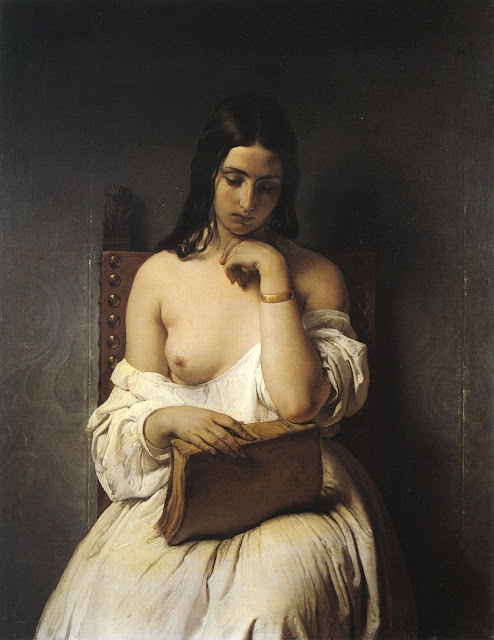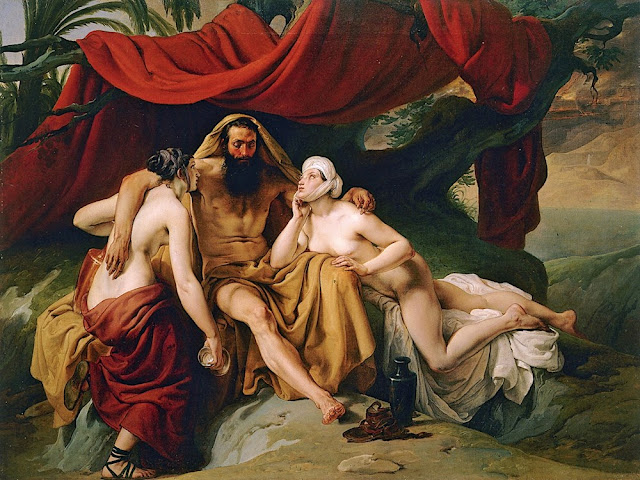Francesco Hayez (1791–1882)
Odalisque, c. 1867
Oil On Canvas
82 x 68 cm - 1867
I have no further description, at this time
An odalisque was a chambermaid or a female attendant in a Turkish seraglio, particularly the court ladies in the household of the Ottoman sultan. In western usage, the term came to mean the harem concubine, and refers to the eroticized artistic genre in which a woman is represented mostly or completely nude in a reclining position, often in the setting of a harem.
More on An odalisque
Francesco Hayez (10 February 1791 – 12 February 1882) was from a relatively poor family from Venice. Francesco was the youngest of five sons. He was brought up by his mother's sister, who had married Giovanni Binasco, a well-off shipowner and art collector. Hayez displayed a predisposition for drawing since childhood.
His uncle, having noticed his precocious talent, apprenticed him to an art restorer in Venice. Hayez would later became a pupil of the painter Francesco Maggiotto with whom he continued his studies for three years.
He was admitted to the painting course of the New Academy of Fine Arts in Venice in 1806, where he studied under Teodoro Matteini. In 1809 he won a competition from the Academy of Venice for a one year residency at the Accademia di San Luca in Rome.
He remained in Rome until 1814, then moved to Naples where he was commissioned to paint a major work depicting Ulysses at the court of Alcinous. In the mid-1830s he attended the Maffei Salon in Milan, hosted by Clara Maffei. Maffei's husband would later commissioned Hayez a portrait of his wife (See below). In 1850 Hayez was appointed director of the Brera Academy.
Francesco Hayez (1791–1882)
Portrait of Clara Maffei (1814-1886), c. 19th century
Oil on canvas
MAG Museo Alto Garda, Riva del Garda
Elena Clara Antonia Carrara Spinelli (13 March 1814, in Bergamo – 13 July 1886, in Milan) was an Italian woman of letters and backer of the Risorgimento, a 19th century political and social movement that resulted in the consolidation of different states of the Italian Peninsula into a single state, the Kingdom of Italy.
Carla is usually known by her married name of countess Clara Maffei or Chiarina Maffei.
At 17 years old she married Andrea Maffei, but they separated by mutual consent on 15 June 1846. She had a long and lasting relationship with Carlo Tenca. More on Clara Maffei
Over the course of a long career, Hayez proved to be particularly prolific. His output included historic paintings designed to appeal to the patriotic sensibility of his patrons as well as works reflecting the desire to accompany a Neoclassic style to grand themes, either from biblical or classical literature. He also painted scenes from theatrical presentations (See below).
Francesco Hayez (1791—1882)
The Last Interview of Jacopo Foscari, c. 1838/1840
Oil on canvas
w233 x h165 cm
Gallerie d'Italia, Piazza Scala Milano
A scene from I due Foscari (The Two Foscari), an opera in three acts by Giuseppe Verdi to an Italian libretto by Francesco Maria Piave, based on the 1821 historical play, The Two Foscari by Lord Byron.
In this canvas is an older self portrait of Hayez himself, and with a dramatic gesture he forces his son to respect the decision of the Council of Ten, as he leans on his stick trembling with emotion. The differing reactions of the figures around him are evident: the silent suffering of the women; the icy expression of Jacopo’s enemy Loredano standing beside him, as the condemned son stretches out his hands towards his father; the various emotions of the children.
The painting was commissioned in 1838 by Emperor Ferdinand I, who had arrived in Milan for his coronation as king of Lombardy and Veneto, and it was destined for the Belvedere Gallery in Vienna. On its completion in 1840 the work was valued at the extremely high price of five thousand florins by the Commissione Permanente di Pittura dell’Accademia di Brera, which thus recognized its exceptional quality. In 1928.
More on this painting
Hayez's subjects are often dressed in austere, black and white clothing, with little to no accoutrements. While Hayez made portraits for the nobility, he also explored other subjects like fellow artists and musicians. Late in his career, he is known to have worked using photographs.
Francesco Hayez (1791–1882)
Meditation on the New and Old Testaments, c. 1850
Oil on canvas
Height: 90 cm (35.4 in); Width: 70 cm (27.5 in)
Private collection
Francesco Hayez (1791–1882)
Meditation on the History of Italy, c. 1850
Oil on canvas
Height: 90 cm (35.4 in); Width: 70 cm (27.5 in)
Private collection
Conspicuously absent from his oeuvre, however, are altarpieces - possibly due to the Napoleonic invasions that deconsecrated many churches and convents in Northern Italy. Art historian Corrado Ricci described Hayez as a classicist who then evolved into a style of emotional tumult.
Francesco Hayez (1791—1882)
Lot and His Daughters, c. 1833
Oil on canvas
Francesco Hayez (1791–1882)
Rebecca At The Well
Oil on canvas
44⅛ by 33½ in.; 112 by 85 cm.
In the present work, a Milanese model is shown as the Old Testament figure of Rebecca (Genesis 24), shown at the well where she would be chosen as the wife of Isaac. Her smooth and neoclassical figure, is set against an exotic and arid landscape. With her left arm resting on an amphora and her right set across her bare chest, she looks towards the audience with an intense and moving gaze.
Francesco Hayez (1791–1882)
Rebecca At The Well, c.1848
Portrait of Teresa Manzoni Stampa Borri
Oil on canvas
113х85
Hayez must have considered Rebecca at the well as an important composition, as he returned to it again in 1848.5 This later version, today in the Accademia di Brera in Milan, compares in dimensions and overall impression, though the landscape is slightly different as is the pose and costume of Rebecca. Both works, however, preserve the arresting and captivating quality of Rebecca's glance (See above).
Francesco Hayez (1791–1882)
Virsheba at her bath, c. 1845
Oil on canvas
107 х 77
Metro Milan, Pinacoteca Brera
Francesco Hayez (1791–1882)
Birsheba (Bathsheba) , c. 1827
Oil on canvas
149.9 x 115.6
Private collection
Francesco Hayez (1791–1882)
Mary Magdalene as a hermit, c. 1833
Oil on canvas
Height: 118 cm (46.4 in); Width: 150 cm (59 in)
Galleria d'arte moderna di Milano
commissioned by Baron Ciani di Lugano
Hayez's outlines a minimalist landscape in the background: the cold, cerulean-clad silhouette of the solitary Mary Magdalene against this backdrop, her hand gently gripping the cross. Magdalene's expression suggests a sense of melancholy and grief, symbolizing the eternal conflict between religious vocation and earthly desires.
Hayez had already dealt with the iconography of Mary Magdalene as a hermit in the desert in an 1825 painting—currently kept in a private collection. More on this painting
One of Hayez's favorite themes was semi-clothed Odalisques, evocative of oriental themes – a favorite topic of Romantic painters. The depictions of harems and their women allowed artists the ability to paint scenes otherwise not acceptable within society. Even Hayez's Mary Magdalene (See above) has more sensuality than religious fervor.
Francesco Hayez (1791–1882)
Odaliske, c. 1867
Oil on canvas
Height: 82 cm (32.2 in); Width: 68 cm (26.7 in)
Pinacoteca di Brera, Milan, Italy
Francesco Hayez (1791–1882)
Female nude, c. 1859; Italy
Oil, canvas
105 x 70 cm
Location: Palazzo Brera, Milan, Italy
Francesco Hayez (1791–1882)
The Kiss, c. 1859
Oil on canvas
Height: 110 cm (43.3 in); Width: 88 cm (34.6 in)
Pinacoteca di Brera, Milan, Italy
Hayez's painting The Kiss (See above) was considered among his best work by his contemporaries, and is possibly his most well-known effort. The anonymous, unaffected gesture of the couple does not require knowledge of myth or literature to interpret, and appeals to a modern gaze.
Francesco Hayez (1791–1882)
Crusaders Thirsting near Jerusalem, c. 1836-50
Oil on canvas
Palazzo Reale, Turin
This is a fine example of the type of grandiose painting that Hayez produced on historical and literary subjects. He was often inspired by themes taken from the Middle Ages. Hidden under historical symbolism, they were really about the Italian Risorgimento. Similarly, classical subjects were chosen to evade censorship. More on this painting
A scientific assessment of Hayez's career has been made complicated by his proclivity for not signing or dating his works. Often dates in his paintings indicate when the work was acquired or sold, not the time of its creation. Moreover, he often painted the same compositions several times with minimal variations if any at all.
Francesco Hayez (1791–1882)
Destruction of the Temple of Jerusalem, c. 1867
Oil, canvas
82 x 183 cm
Gallerie dell'Accademia, Venice , northern Italy
The focal point of the image is the fighting taking place on the giant stone altar in the middle of the Temple precinct. This stone altar, used for burning the offerings specified in Deuteronomy 27:6-7, was an actual feature of the Second Temple buildings. In this respect Hayez's work represents a move towards a more architecturally accurate rendering of the Temple. Nevertheless, the placement of the altar is inaccurate, as are the steps, as the stone altar was accessed by a ramp.
The symbolism inherent in the Jewish victims being thrown to their deaths from the altar is typical of Hayez’s allegorical style. The sense of sacrilegious chaos is also echoed by the visible theft of the golden menorah, the holy seven-armed candlestick, in the foreground of the image, as well as by the flight of a group of angels in the top left hand corner of the painting.
More on this painting
Among his pupils from the Brera Academy were Carlo Belgioioso, Amanzio Cattaneo, Alessandro Focosi, Giovanni Battista Lamperti, Livo Pecora, Angelo Pietrasanta, Antonio Silo, Carlo Antonio Tavella, Ismaele Teglio Milla and Francesco Valaperta.
Hayez died in Milan, age 91.
Please visit my other blogs: Art
Collector, Mythology, Marine
Art, Portrait of a Lady, The
Orientalist, Art of the Nude and The
Canals of Venice, Middle
East Artists, 365
Saints and 365 Days, also visit my Boards on Pinterest
Images are copyright of their respective owners, assignees or others.
Some Images may be subject to copyright
I don't own any of these images - credit is always given when due unless
it is unknown to me. if I post your images without your permission, please tell
me.
I do not sell art, art prints, framed posters or reproductions. Ads are
shown only to compensate the hosting expenses.
If you enjoyed this post, please share with friends and family.
Thank you for visiting my blog and also for liking its posts and pages.
Please note that the content of this post primarily consists of articles
available from Wikipedia or other free sources online.


















.jpg)

No comments:
Post a Comment